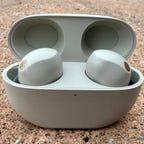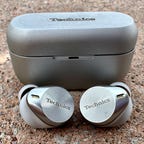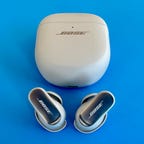Best-Sounding Wireless Earbuds in 2024: Get Top Sound Quality
Looking for wireless earbuds with truly excellent sound quality? Check out our top picks in every price range.
What to Consider
Budget
Fit
Return Policy
Our Picks
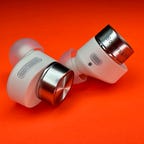
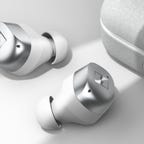
Which are the best-sounding wireless earbuds?
In my nearly 20 years of testing audio, I've used hundreds of earbuds and have encountered many buds that sound good, but only a few that sound truly great. But sound is subjective, so it's hard to declare one set of earbuds the best-sounding pair. There are a few, however, like the new Sennheiser Momentum True Wireless 4, the Bowers & Wilkins PI7 S2, the Sony WF-1000XM5 and even Apple's AirPods Pro 2, which deliver impressive sound considering how lightweight and small they are.
Size and fit also play into sound quality, which suffers if you can't get a good fit. Not all, but many of the best-sounding earbuds tend to be on the bigger side and may not fit some ears. To get optimal sound quality -- and bass performance, in particular -- it's crucial to get a tight seal, so finding a set of buds that fit your ears well is an important part of the sound quality equation.
I've fully tested all the earbuds on this list and fully reviewed many of them. I'll update these picks as new great-sounding earbuds hit the market.
Best-sounding wireless earbuds of 2024
Bowers & Wilkins has upgraded its fantastic-sounding PI7 noise-canceling earbuds. The new S2 model has better battery life and Bluetooth range, now up to 25 meters (double the previous range). Additionally, the buds now integrate into the new Bowers & Wilkins Music app for iOS and Android and have a much-improved setup experience.
While not a major upgrade from the originals, the PI7 S2s, which feature a dual-driver design, are easily among the very best-sounding true-wireless earbuds. The step-down PI5 S2s, which have a single-driver design, don't sound quite as good but are more affordable.
Best Sony earbuds
Sony WF-1000XM5
When Sony's WF-1000XM4 earbuds came out in 2021, we awarded them a CNET Editors' Choice. And while they're excellent, we had some quibbles -- they're on the large side and aren't a good match for certain ears. Clearly, Sony took those gripes to heart when it set out to design its next-generation WF-1000XM5 flagship noise-canceling earbuds. Not only are the XM5s smaller, but they also offer improved performance pretty much across the board, with better noise canceling, sound and voice calling. Are the XM5s perfect? Not quite. At $300 -- $20 more than their predecessor -- they're costly, too. Overall, they're really impressive -- easily among the very top earbuds on the market.
Best Technics wireless earbuds
Technics EAH-AZ80
You should expect a lot from earbuds that cost $300 -- and yes, that's still a lot to pay for headphones, even if plenty of people seem to be willing to pay upwards of $450 for the likes of Apple's AirPods Max headphones. Overall, Panasonic has done a nice job of creating an all-around top-performing set of buds that offer an improved fit with terrific sound, very good noise canceling and a robust feature set.
Voice-calling capabilities are decent but don't quite live up to their billing (yet). Hopefully, we'll see some firmware upgrades that improve the voice-calling experience in noisier environments. Despite that caveat, as long as they fit your ears well, the Technics EAH-AZ80 is right up there with the best wireless earbuds on the market right now.
Best-sounding Sennheiser wireless earbuds
Sennheiser Momentum True Wireless 4
Whenever a new pair of Momentum True Wireless earbuds drops, I always find myself saying, "Wow, these sound good." Sound quality has always been the MTW's biggest strength, and that remains the case with the fourth-gen version.
There's been some modest improvements in other areas, particularly with the noise-canceling performance and the reliable, hiccup-free Bluetooth connection I had with my phone. At the same time, the voice-calling performance could be better, and I'm a little disappointed that these aren't even more of an upgrade over their predecessor. Still, the Momentum True Wireless 4 are excellent earbuds that I have no problem recommending.
Best for noise-canceling
Bose QuietComfort Ultra Earbuds
While the QC Ultra Earbuds aren't a major upgrade over Bose's excellent QC Earbuds 2 that were released in 2022, they're a little better. They should fit most ears very well, and they feature superb noise canceling, arguably the best out there. A natural-sounding transparency mode with a new ActiveSense feature kicks in some ANC should the sound get too loud around you (it's sort of similar to the AirPods Pro's Adaptive Audio feature). They also sound slightly better overall, with a touch more clarity, and their new Immersive Audio feature opens up the sound a bit.
Best-sounding budget noise-canceling earbuds
Earfun Air Pro 3
Earfun has put out a series of wireless earbuds over the last couple of years with one important commonality: They're very good values, made more so by frequent discounts. The company's Earfun Air Pro 3 earbuds feature the latest Qualcomm QCC3071 system-on-a-chip with AptX Adaptive for Android and other devices that support the new LE Audio standard and LC3 audio codec, which is superior to the SBC codec (they also support AAC for Apple devices).
Lightweight and comfortable to wear -- I got a good seal with the largest ear tip size -- these aren't a huge upgrade over the Earfun Air S, but they are better. They have slightly larger wool-composite drivers (11mm versus 10mm), slightly improved noise canceling and better battery life (up to seven hours with noise canceling on, according to Earfun).
In short, the Earfun Air 3 delivers strong performance for its modest price, with robust bass, good clarity and a relatively wide soundstage. They also pack in a lot of features, including a wireless charging case and "multidevice" connectivity. (I could pair them to two devices simultaneously but had to pause the music on one device and hit play on the other for the audio to switch.) They're IPX5 splash-proof and also work well (though not exceptionally well) as a headset for making calls.
Use the code EAP3CNET at checkout at Amazon to drop the price to just less than $50.
Pros:
- Relatively inexpensive
- Good sound and overall performance for their price
- Wireless charging and support for new Bluetooth LE Audio standard
Cons:
- Voice calling performance is only OK
Best Apple noise-canceling wireless earbuds
Apple AirPods Pro 2 (USB-C)
The AirPods Pro (2nd generation) are powered by Apple's new H2 chip, which delivers more processing power while being more energy efficient, according to Apple. The new chip, combined with new low-distortion drivers, allows for improved sound that offers better clarity and depth. The noise canceling is also improved -- Apple says the new AirPods have "double" the noise canceling of the original AirPods Pro. Additionally, the new AirPods add an extra hour of battery life, up from five to six hours with noise canceling on. Plus, a speaker in the case that emits a sound that helps locate your buds via Find My, should they decide to hide from you.
Top midrange earbuds
Edifier NeoBuds Pro 2
If you can't quite afford the AirPods Pro 2, the Edifier NeoBuds Pro 2 may be a good alternative. They aren't a huge upgrade over the original NeoBuds Pro, but their list price is around $50 less and they have a lightweight premium design, good sound for their price, effective noise cancellation and come with seven sets of ear tips to help you get a good fit. They also have ear-detection sensors and spatial audio with head tracking.
With support for the LDAC, LHDC, and AAC audio codecs, they're good for both iPhone and Android users (many Android devices support LDAC audio streaming). Equipped with four microphones in each bud, I also thought they worked well for voice calls, although not quite as well as the AirPods Pro 2, which are marginally better overall. While I was slightly disappointed with the limited touch control and thought the spatial audio and battery life could be a little better (they're rated for around 4 hours with noise canceling on and 5.5 hours with it off), the NeoBuds Pro 2 offer a good combination of mostly impressive performance in a nice design. You can tweak their sound in their companion app for iOS and Android.
Top gaming earbuds with excellent sound
Sony Pulse Explore
There a lot of new gaming earbuds out there but what makes the Sony Pulse Explore earbuds special is that they feature planar magnetic drivers, a speaker technology typically found in high-end over-ear audiophile headphones but rarely in earbuds. While they're missing some features fond in typical premium earbuds (noise canceling and ear-detection sensors), that they're as good as they are for listening to music and making calls is a revelation. In fact, they sound clearer and more articulate than Sony's flagship WF-1000XM5 earbuds, with tight, powerful bass. That doesn't necessarily mean they sound better than XM5s, which sound a little fuller. But I wasn't expecting them to compete at all with the XM5s for music listening.
Top wireless earbuds with new xMEMS drivers
Creative Labs Aurvana Ace 2
There's been some hype recently around solid-state semiconductor Micro-Electromechanical System, aka MEMS, speakers and you can find xMEMS drivers in Creative Labs' Aurvana Ace ($130) and Ace 2 earbuds ($150). The newer Ace 2 has support for Qualcomm's AptX Lossless for the limited number of devices that support that audio codec but otherwise the two models seem nearly identical, except for their color schemes. While the Ace 2 is missing features like ear-detection sensors that are often found in buds in this price range, they do sound quite impressive (if you get a tight seal), with nicely detailed, accurate sound and well-defined bass that has some warmth to it (it does help to play around with the companion app's equalizer settings to optimize the sound to your liking). I found their adaptive noise canceling good, though not necessarily great. The same was true for the voice calling performance.
Overall the buds are well-designed and have some eye-catching design elements that help them stand out from other earbuds with stems. They're IPX5 splash-resistant, are rated for up to 6 hours of battery life on a single charge at moderate volume levels and offer wireless charging. For their price, they deliver good bang for your buck, particularly when it comes to sound quality.
Best wireless earbuds with triple drivers
Status Between 3ANC
Status Audio's earbuds aren't exactly the sleekest or most attractive earbuds you can buy, but if you don't mind their utilitarian look and giant stems, you are getting an excellent-sounding set of earbuds. The Between 3ANC, the company's first noise-canceling earbuds, also do a good job muffling ambient sound, though they aren't up to the level of the Bose QuietComfort 2 earbuds for noise-canceling prowess. They did perform very well in my voice-calling test, reducing much of the background noise around me in the streets of New York while picking up my voice clearly, or so callers told me.
While they have multipoint Bluetooth pairing -- you can pair them to two devices simultaneously -- they are missing a few features, including ear-detection sensors, and they only support the AAC audio codec (they're equipped with Bluetooth 5.2), not LDAC or aptX. Some people with Android devices that support those codecs may not be thrilled with that, but, as I said, they sound quite good using AAC, offering clean sound with punchy bass and good clarity. That's in part due to their driver design, and why the buds are on the larger side -- they feature two balanced armature drivers, plus one 10mm dynamic driver in each earbud.
Despite being heavier than earbuds like Apple's AirPods Pro 2, they fit my ears comfortably and securely. Their case charges wirelessly and battery life is very good at up to 8.5 hours with ANC on. There's also a transparency mode that sounds only OK, not great (a physical button on the earbuds activates it) and they have an IPX5 water-resistance rating, which means they can withstand a sustained spray of water. The companion app for iOS is fairly basic, but you can upgrade the firmware and tweak the sound profile with a customizable EQ option.
Pros:
- Excellent sound and a comfortable, secure fit
- Good noise canceling and call quality
- Multipoint Bluetooth pairing
- Good battery life
Cons:
- They're big
- No ear-detection sensors
- Transparency mode sounds only OK
Improved audiophile earbuds
Astell & Kern AK UW100MKII
Astell & Kern's original AK UW100MK buds offered excellent sound but were light on features for $300 earbuds. While the second-gen AK UW100MKII are still light on features (there's no active noise canceling but they do have ear-detection sensors, multipoint Bluetooth pairing and an ambient awareness mode), they do sound impressive, with an upgraded acoustic architecture and premium 32-bit DAC technology.
The company says that the position of the Knowles balanced armature driver "has been moved toward the inside of the ear to better deliver audio details more directly, and the acoustic chamber structure and mesh size have been redesigned in accordance with the new BA position to deliver optimal sound output. This new design took numerous attempts to minimize sound diffusion to provide a more delicate and dynamic performance and richer high-frequency expression."
I thought they sounded clean and clear, and while they don't deliver massive bass (as you'd expect from earbuds tuned for audiophiles who want a more neutral sound profile), the bass does go deep and is tight. The voice-calling performance is supposed to be improved, but it's still not great (callers had a hard time hearing me on the noisy streets of New York). Also, the buds -- while comfortable to wear -- are on the larger side. I did think they did a good job of passively sealing out a good amount of ambient sound, so the lack of active noise canceling was less of a factor than I thought it would be.
Battery life is strong -- the buds are rated for up to 9.5 hours at moderate volume levels -- and the case does offer wireless charging. Powered by a higher-end Qualcomm 5141 chip, the buds support SBC, AAC, aptX Adaptive audio codecs. They do not appear to have a water-resistance.
Great-sounding wireless earbuds
Master & Dynamic MW09
Master & Dynamic headphones and earbuds have always featured unique, eye-catching designs that include premium materials like aluminum, sapphire glass and Kevlar. Its latest MW09 flagship earbuds look pretty similar to its earlier MW08 buds, but have some upgrades on the inside that deliver better performance, particularly when it comes to battery life and noise canceling (it's now very close to what Bose and Sony offer, though not quite at their level for ANC). They're IP54 dust- and splash-proof and despite being on the larger side, I found them comfortable to wear, and they stayed in my ears fairly securely.
If you can get a tight seal (seven ear tips are included), the MW09s sound great. They sound natural, with nice detail and deep bass that's well defined and not overpowering. A touch on the warmer side -- there's no treble push -- with an open, refined quality, they're earbuds you can listen to for long stretches without any listening fatigue. They're right up there with the best-sounding buds.
Other highlights include very strong battery life (up to 16 hours), Bluetooth 5.4 (up to 30-meter range and LE Audio ready) and multipoint Bluetooth pairing. While their voice-calling performance is good, it's not up to the level of the AirPods Pro 2 in terms of noise-reduction and voice clarity during calls. Maybe Master & Dynamic can improve in that area with a firmware upgrade, but either way, they're worth checking out if you're looking for high-end earbuds. They're available in multiple colors.
Best Samsung wireless earbuds
Samsung Galaxy Buds 2 Pro
The Galaxy Buds 2 Pro offers improved noise canceling along with very good sound and voice-calling performance, plus support for high-resolution wireless audio streaming if you're a Galaxy device owner with the right setup. That said, their biggest upgrade may be their new design and smaller size, which make them a better fit for more ears. Aside from their somewhat high price tag, their only drawback is that some of their key features only work with Samsung Galaxy devices.
Pros:
- Very good sound and a more comfortable fit
- Good noise-canceling and voice-calling capabilities
- Assortment of extra features for Galaxy device owners
Cons:
- Somewhat pricey
- Some key features only work with Samsung devices
- No true multipoint Bluetooth pairing
Other top-sounding wireless earbuds we've tested
Jabra Elite 10: Yes, the Elite 10s have some potential drawbacks: Their noise canceling is lighter compared with competitors, they're pricey at $249, and they'll probably have to come down a bit to better compete with the AirPods Pro 2 -- at least for Apple users. Still, they're really good earbuds that are not only comfortable to wear for long periods but also sound excellent. Read our full review.
Sony LinkBuds S: Unlike the "open" LinkBuds, the LinkBuds S are traditional noise-isolating earbuds with tips you jam in your ears. They're more compact and lighter than Sony's former flagship WF-1000XM4 and also feature Sony's V1 processor. (Sony has since released the more compact WF-1000XM5.) While their sound and noise canceling don't quite measure up to either XM4s or XM5s, they're still quite good. They're the Sony buds for people who want 80% of Sony's flagship earbuds' features and performance for significantly less.
Bang & Olufsen Beoplay EX: Bang & Olufsen's $399 Beoplay EX buds are the company's best true-wireless earbuds. They feature a comfortable, secure fit (except perhaps for those with really smaller ears), top-notch build quality, great sound, good noise canceling and improved voice-calling performance over B&O's EQ buds, with three microphones in each earbud they help with reducing background noise while picking up your voice. While they're out of most people's price range, they're arguably the best earbuds out there with stems and offer slightly superior sound to the AirPods Pro 2 with better clarity, deeper more powerful bass and richer, more accurate sound.
1More Evo: Known for delivering good bang for the buck, 1More has released a more premium set of buds that are equipped with a 10mm dynamic driver paired with a balanced armature. They have support for Sony's LDAC codec for high-resolution wireless streaming over Bluetooth with music services like Qobuz or Tidal that offer high-resolution music files. The Evo buds sound better than the company's other earbuds, offering better clarity and bass definition as well as a relatively wide soundstage. They also feature solid noise canceling, multipoint Bluetooth pairing, wireless charging, a transparency mode and an IPX4 splashproof rating. Battery life is rated at 5.5 hours with ANC on and 8 hours without it off. A 15-minute quick charge gives you 4 hours of juice.
Audio-Technica ATH-TWX9: Audio-Technica has put out several truly wireless earbuds over the last few years, but none of them have been good. That changes with the ATH-TWX9, which sports a premium design plus premium sound and a pretty robust feature set, including strong active noise canceling, Multipoint Bluetooth pairing and a case equipped with wireless charging and UV LED sterilization. In the box, you'll also find a plethora of ear tip options and I was able to tight seal and comfortable fit. These buds are IPX4 splash-proof and are rated for 6 hours of battery life at moderate volume levels.
Beyerdynamic Free Byrd: Beyerdynamic may be late to the game, but it's finally introduced its first true-wireless earbuds, which feature active noise canceling, up to 11 hours of battery life (with noise canceling off) and impressive sound quality. Read our Beyerdynamic Free Byrd review.
Sony WF-1000XM4: Released in 2021, Sony's WF-1000XM4 earned a CNET Editors' Choice Award. They're still excellent earbuds, but Sony has now released the next-gen WF-1000XM5. They may be a good option if you find them at a good discount.
Final Audio ZE8000: Japan-based Final Audio, which makes some high-end audiophile headphones, including the $4,299 D8000 Pro, has released its ZE8000 ($199) true-wireless earbuds that feature a unique stick design and excellent sound. The largest tips fit my ears comfortably and securely, though they do stick out a bit.
Sennheiser Momentum True Wireless 3: The Sennheiser Momentum True Wireless 3 were among the best new true-wireless earbuds of 2022. They're still among the best true-wireless earbuds, but Sennheiser has released the upgraded Momentum True Wireless 4. Also, the newer AirPods Pro 2 and Sony WF-1000XM5 buds are arguably superior, so only look to buy the Momentum True Wireless 3 when they're significantly discounted.
JBL Live Pro 2: Over the years, JBL has put out some decent true-wireless earbuds, but nothing that really got me too excited. That's finally changed with the arrival of the Samsung-owned brand's new Live Pro 2 and Live Free 2 buds. Both sets of buds -- the Live Pro 2 have stems while the Live Free 2 have a pill-shaped design -- offer a comfortable fit along with strong noise canceling, very good sound quality and voice-calling performance, plus a robust set of features, including multipoint Bluetooth pairing, an IPX5 splash-proof rating and wireless charging.
Factors to consider when choosing wireless earbuds
Budget
Before anything else, you'll want to figure out how much you're willing to spend on new earbuds. Value priced earbuds continue to improve, so you can find good "cheap" buds for not too much money (less than $60). But if you're looking for premium buds from Sony, Apple and Bose, be prepared to spend a lot more.
Fit
It's key that the earbuds you buy fit your ears well. They should offer a comfortable, secure fit. If you don't get a tight seal with noise-isolating earbuds, sound quality and noise canceling can be dramatically impacted for the worse. Open earbuds don't have that issue, but they should be comfortable to wear and sit securely in your ears.
Return policy
Because the fit of your earbuds is so important, it's critical to buy your buds at a retailer that has a good return policy, in case the buds aren't a good match for your ears.
How we test true-wireless earbuds
We test true-wireless earbuds based on five key criteria, comparing similarly styled and priced models. These criteria are design, sound quality, features, voice-calling performance and value.
- Design: We assess not only how comfortable the earbuds fit (ergonomics) but also their build quality and how well the controls are implemented. We also look at water- and dust-resistance ratings.
- Sound quality: We evaluate sound quality by listening to a set playlist of music tracks and comparing the earbuds to top competing products in their price range. Sonic traits such as bass definition, clarity, dynamic range and how natural the headphones sound are key factors in our assessment.
- Features: Some great-sounding earbuds aren't loaded with features, but we do take into account what extra features are on board. These include everything from noise-canceling and transparency modes (ambient sound mode) to special sound modes to ear-detection sensors that automatically pause your music when you take the headphones off your ears.
- Voice-calling performance: When we test voice-calling performance, we make calls in the noisy streets of New York and evaluate how well the earbuds reduce background noise and how clearly callers can hear your voice.
- Value: We determine value after evaluating the strength of the earbuds against all these criteria and what the buds are able to deliver compared to other models in their price class.
Best-sounding wireless earbuds FAQ
What makes for great-sounding wireless earbuds?
The best-sounding wireless earbuds offer clean open sound with strong, well-defined bass. The best of the best sounding earbuds allow you to hear each instrument separately in complicated and offer a level of detail, depth and refinement not found in lesser buds.
Do the best sounding earbuds all cost a lot?
Many do but you can find earbuds with good sound for a little more than $100 and sometimes less. The top-sounding earbuds do tend to cost over $200.
Are the best-sounding earbuds larger than most earbuds?
Many but not all. The best-sounding earbuds tend to have larger drivers or dual drivers so they're larger as a result.


